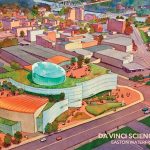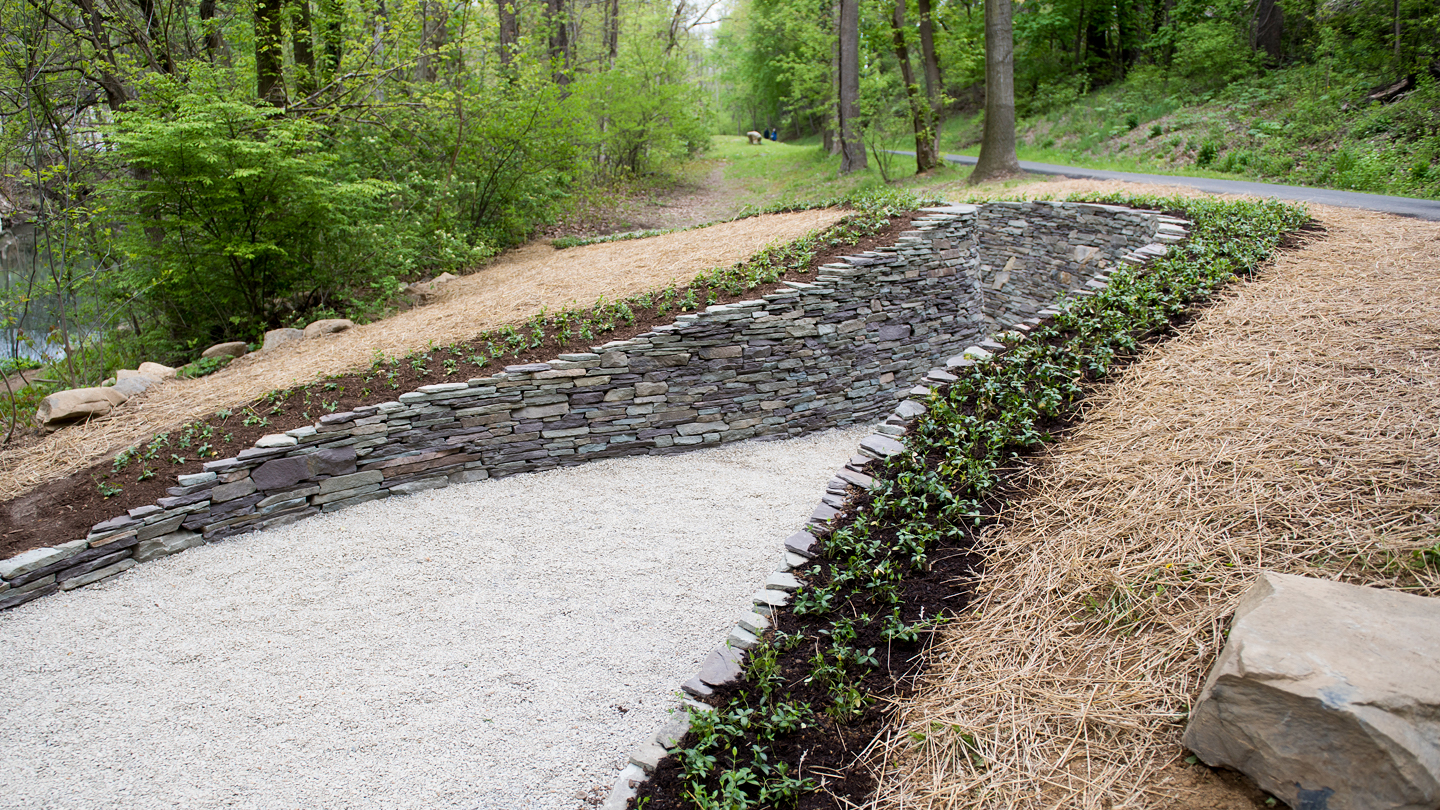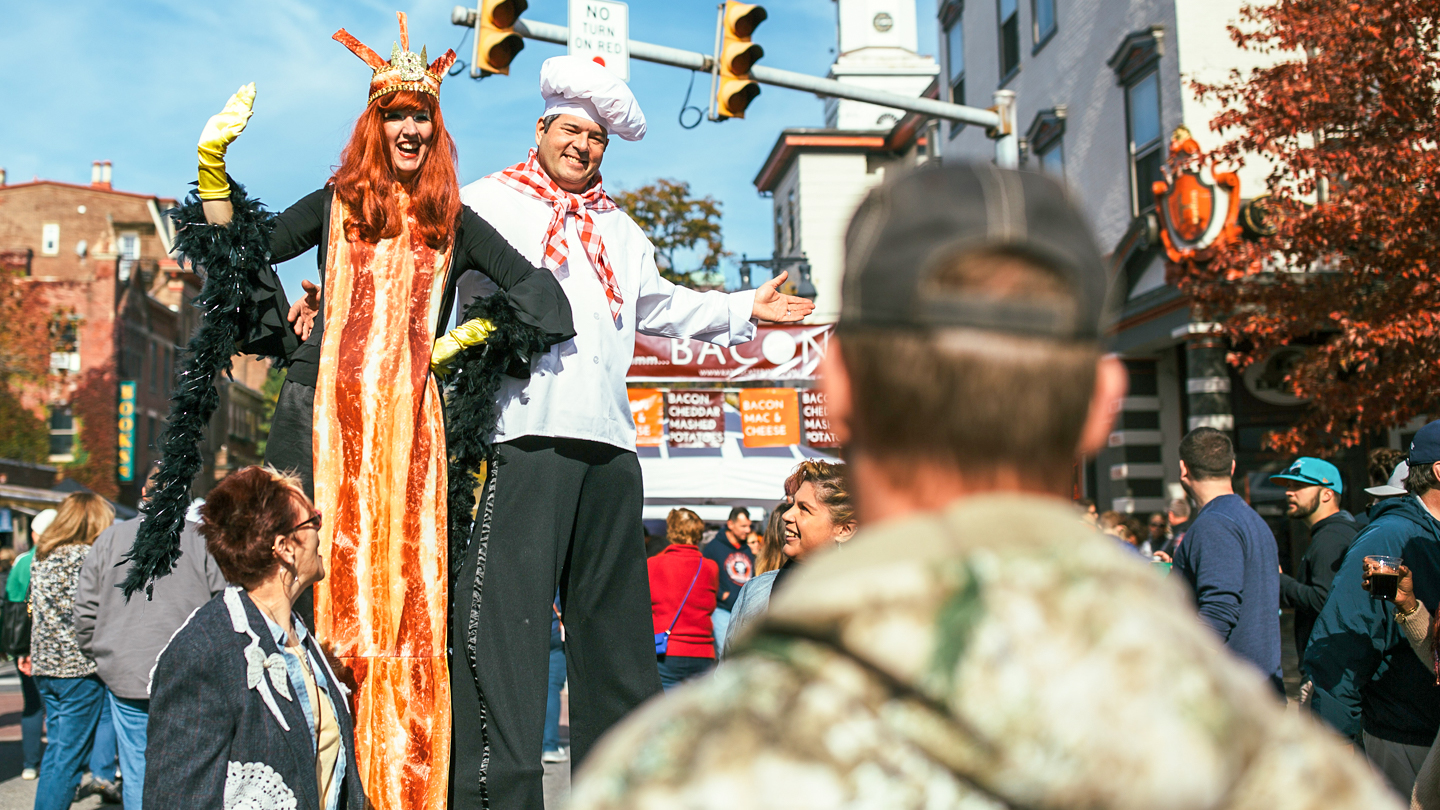Related Articles
Da Vinci Science City and aquarium
 A new aquarium and science center in downtown Easton might sound like a draw for tourists, but how can they be designed to enhance the lives of local residents?
A new aquarium and science center in downtown Easton might sound like a draw for tourists, but how can they be designed to enhance the lives of local residents?
Easton has reversed its fortunes in recent years. Lafayette has helped.
Easton Mayor Sal Panto Jr. is leading a small group of Lafayette alumni through the city’s downtown one morning in early June.
Instead of mimicking the curator of a history museum—here in the town traffic circle is where one of three inaugural public readings of the Declaration of Independence took place—Panto sounds like a giddy child showing off his new toys.
“This is Mesa,” he says, pointing to the upscale south-of-the-border eatery on Third Street. “And up there is the 3rd & Ferry Fish Market.”
They’re just two of 18 eateries that have risen from the half mile around Easton’s Centre Square in the past decade. It wasn’t all that long ago that Panto’s tour might have dragged Lafayette alumni through deserted streets with shuttered storefronts.
But a new Easton is emerging, and the College is among those helping to resurrect its glory.
Facing north on Northampton Street
Deteriorating buildings near the confluence of the Delaware and Lehigh rivers have been transformed into a brewery and luxury apartments. A sparkling new intermodal center housing Easton’s new city hall, a bus station, a parking deck, and retail space has taken shape a few blocks away. Defunct factories, failed department stores, and forgotten open space have transformed into condos, new eateries, and well-tended city parks.
Like any urban renaissance, this one didn’t happen overnight, but the Easton of old isn’t even in the memory banks of Bob Lefelar ’62 of Wayne, N.J., who was along on the tour offered as part of Reunion Weekend.His few interactions with the city happened at Young Republican Club, a defunct bar on North Delaware Drive, which wasn’t part of downtown.
“I rarely came downtown,” he says. “There was nothing that it offered us.”
Now, students are drifting down the hill in droves, working on projects with community partners, and drinking cold-brewed coffee at the sprawling indoor Easton Public Market on Northampton Street.
“Easton’s success is important to the future of Lafayette,” says President Alison Byerly, who is leading efforts to grow the student body by 400 and faculty by 40 in the next six to eight years as a way to make the College more affordable and distinctive. “Our growth strategy both benefits from, and contributes to, the city’s continued development. As Easton continues to develop and grow into an even more attractive destination for students and families, its identity as a vibrant and welcoming community also helps us recruit talented faculty and staff.”
Town and gown are key drivers of one another’s destiny. It took foresight and leadership to recognize that.
The Easton you might remember during the mid-1970s and 1980s: From the Soldiers and Sailors Monument spiking from Centre Square ringed a sea of shuttered businesses and dilapidated buildings. The town was dirty. Violent crime was a reality. As recently as 2001, a second holdup at Barlow’s Fine Jewelers on the corner of Second and Northampton streets led to its closure.
The Easton many alumni recall was swirling down a long spiral.
In what some locals still consider Easton’s salad days of the 1950s, Pomeroy’s, the big department store, and other shops drew the crowds. They tapered off to nothing during the 1980s and 1990s as shoppers shifted to malls and suburban box stores. At the same time, some of Easton’s old neighborhoods and classic buildings were being razed to make way for highways and parking lots—victims of Easton’s embrace of federal urban renewal policies. Pomeroy’s spent decades as a boarded-up husk in the middle of town.
“If people asked you where you were from, where do you live, you mumbled ‘Easton,’” says Richard McAteer, member of Easton’s Redevelopment Authority. “It was really not good.”
When Jim Krivoski, vice president and liaison to the Board of Trustees, began at Lafayette in 1985 in the student life division, students still took a dim view of what was at the foot of College Hill.
“There was such a divide between the downtown and the College,” he says. “It was unspoken, but there was just an attitude among students that you don’t go down there. Almost like it’s a dangerous place.”
“We used to say it was like sighting a rare bird,” says Kim Kmetz, manager of the Easton Main Street Initiative. “If you saw [a student] you’d get really excited.”
“There really was a sense of ‘We’re different; we’re separate,’” says state Rep. Robert Freeman, D-Northampton.
In 1995, then Mayor Thomas Goldsmith ’63 announced the opening of Two Rivers Landing, which would become home to the Crayola Visitors Center and National Canal Museum. The State Theatre on Northampton Street continued to draw famous acts to the region.
But it wasn’t enough.
Corner of 3rd and Ferry streets
By the start of the second mayoral administration of Republican Phil Mitman in 2004, the city was on the verge of collapse. Officials were working on the paperwork to request Act 47 status—Pennsylvania’s bankruptcy protection of sorts for distressed municipalities. The act, a last-resort plea to the state to help financially distressed cities rebound, is hardly foolproof, and some cities languish for years unable to pay their bills. In fact, only about 25 percent of cities become self-sufficient through Act 47.
Easton needed a way out.
Then Pennsylvania Gov. Ed Rendell had given more than $2 billion in grants to struggling Pennsylvania cities and boroughs looking to revitalize their downtowns. Rendell and his team liberally applied the Redevelopment Assistance Capital Program (RACP), which helped boost downtown beautification jobs across the Commonwealth. But RACP (or R-Cap as it’s known to government wonks) came with a catch—the city had to match the state’s investment.
For Easton, McAteer says, that was impossible. “We couldn’t afford a lawn mower,” he says. But Mitman and then Lafayette President Arthur Rothkopf ’55 had a novel solution.
By then, relations with the College had begun to warm. Mitman, who grew up in Easton, the son of a Lafayette alumnus, maintained a good rapport with College administration. Rothkopf had been part of the Two Rivers Landing deal.
“There was a real change starting with President Arthur Rothkopf,” Freeman explains. “He was the first president who really wanted to break out of that isolation on campus. He really engaged the city. He tried to have the College partner with the city and have the College become more a part of the city.”
The College had purchased a portion of North Third Street, a once ramshackle city block at the bottom of the hill, in hopes of developing a better gateway to its leafy grounds from busy Route 22. Plans had settled upon building an arts campus there, and the College had invested millions. Could those millions count as the municipal match in the RACP formula?
Rothkopf, Mitman, and McAteer drove to Harrisburg and met with the governor and Larry Segal, executive director of the governor’s office of housing and community revitalization.
Both state officials agreed—Easton could apply for the state funds on Lafayette’s dime.
There was just one problem. “The application was this thick,” McAteer says, holding inches of air between his thumb and forefinger, and the city lacked the expertise in filling it out.
Lafayette’s then vice president and treasurer Fred Quivey, with help from Segal, actually completed the application.
In 2005, the College and the city received the $9 million RACP grant from the state. Lafayette used its share to continue development on North Third Street. Easton’s Redevelopment Authority used a portion of the funds to buy a sprawling defunct silk mill in the West Ward—a large, open wound developers were loath to buy because of environmental remediation costs. Easton planned to woo a developer to transform it into an artists’ community. It used another $3 million to purchase a 2-mile swath of scrub brush between the silk mill and downtown for an arts trail.
The grant turned out to be worth far more than the $9 million. It spurred a surge in downtown redevelopment and everything that followed.
“It made us legitimate,” McAteer says.
Rothkopf’s engagement with the city wasn’t just about being a good neighbor.
“So what we used to sell was ‘Hey, we’re close to New York. That’s cool,’” Krivoski says. “‘Hey, we’re close to Philadelphia. We’re close to the Poconos.’ We never said, ‘You’re going to love Easton.’ It wasn’t bad-mouthing it. It was almost hiding it.”
When Daniel Weiss took over as Lafayette president in 2005, he put Rothkopf’s efforts to engage the city at the forefront.
“I made it a high priority,” says Weiss, who left Lafayette in 2013 and now serves as president and chief operating officer of New York Metropolitan Museum of Art. “It was in our self-interest because we aren’t going anywhere. We’re members of the community, and we would do better if the city does better.”
Armed with the new grant, the city set about cleaning up its own streets. Businesses began to take notice. New Jersey-based developer Mark Mulligan bought the old Pomeroy’s building on Northampton Street—perhaps the biggest empty space in the heart of downtown—for $6 million in 2006.
Pomeroy’s Building sat vacant for decades before Mark Mulligan bought it and turned it into upscale condos and restaurants.
Lafayette pitched in. Students in the College’s Technology Clinic course developed an idea to help spruce up the dilapidated downtown. They researched and eventually drafted a request for proposals for the city to create a street beautification patrol called Easton Ambassadors.
Weiss recognized the simple genius of the idea, which was based on a Kentucky company called Block by Block. “I thought it was important,” Weiss says. “So we put our own skin in the game, and we went out.”
He committed about $300,000 to the project—a third of the overall cost. And when he discovered some local businesses were hesitant to donate more funds to lift Ambassadors off the ground, Weiss went door to door with Mitman in tow to ask for their support.
In 2008, Easton’s first Ambassadors took to the streets. Nine years later, the Greater Easton Development Partnership continues to oversee the program for the city, as well as other downtown initiatives. Jared Mast ’04, executive eirector of GEDP, notes the College continues to be a strong partner to GEDP in executing the revitalization strategy for downtown Easton. “As an alum and Eastonian, it’s exciting to build on this long-standing partnership and to find new ways to work together and move Easton and the College forward,” he says.
Today, when you visit downtown, someone in a red short-sleeved shirt might offer you directions, a greeting, or a smile while lifting a crushed soda can from the sidewalk. Easton’s eight Ambassadors scrub graffiti, plant and water flowers, shovel snow, and help fill gaps in city services.
In 2011, Greater Lehigh Valley Chamber of Commerce honored Lafayette for its contributions to the city.
“Without Lafayette, the city would not be what it is today,” Panto said at the presentation.
By then, Easton had developed a reputation as an up-and-coming city. Today, many say the College’s hometown has arrived.
A developer is installing high-end apartments, shops, and studio space at Simon Silk Mill. Dubbed Silk, it is the largest commercial-residential project the city has seen in recent memory.
The $3 million worth of land the city bought near Bushkill Creek is now Karl Stirner Arts Trail, a 2.5-mile paved walk where sculpture, a dog park, and The Young Masters Wall emerge from the trees. Jim Toia, Lafayette’s director of Community-Based Teaching, helps curate sculptures for the trail.

Paul Deery’s installation Waterway on the Karl Stirner Arts Trail.
Downtown bellwethers like Crayola and the State Theatre are flourishing. In 2013, Crayola expanded from a visitors center to an indoor theme park called Crayola Experience. More than 400,000 people a year visit it, filling the parking garages and Easton’s once somber streets.
And, perhaps more remarkably, Lafayette is no longer just spires on the hill overlooking Easton. It has moved downtown, literally. The North Third Street corridor is now the vaunted Williams Arts Campus—four buildings that feature studio space, theaters, and filmmaking rooms.
In late 2016, the College moved 53 employees to three floors of office space in the Alpha Building on Centre Square and named it Lafayette Downtown. Recently, the renaissance has kicked into high gear. Food festivals such as the world-renowned PA Bacon Fest in Centre Square draw tens of thousands to the city. At the indoor Easton Public Market, local vendors serve up crepes, craft beer, and gourmet noodle bowls. The city’s outdoor farmers market—which once had dwindled to one stand—fills Centre Square on weekends with shoppers buying local fare.
Lafayette’s involvement is often monetary. Sometimes the figures aren’t astronomical: Look for the College among the sponsors of local initiatives like Easton Out Loud, a local night out the fourth Friday of every month. Sometimes the dollar amount is more significant: In January, the College donated a $560,000 fire truck to Easton’s emergency arsenal.
Byerly, like her predecessors, has been a fixture at local events, demonstrating the College’s support at concerts, charity auctions, festivals, and the farmers market. Faculty and staff serve on community and nonprofit boards. (Byerly’s husband, Steve Jensen, is on the Sigal Museum board.)
But while Lafayette’s engagement was a key ingredient in Easton’s downtown rebirth, it wouldn’t have happened without the investment and help of the city’s shop owners, city leaders, and officials.

Easton’s annual world famous Bacon Fest
And few have meant more to the effort than the smiling tour guide that early June morning, Panto.
Mayor from 1984 to 1992, Panto was elected again to the office in 2008 as Mitman’s successor. Under his watch, Easton’s tax rate has remained a flat line, and grant money has flowed into the city along with developers.
“As a partner to me, I couldn’t have asked for a better mayor,” Weiss says. “The way I was marching around the city, Sal was marching around doing what he could do for the College. We created something really valuable.”
During the opening weekend of the fall 2017 semester, about 700 students came downtown from College Hill. They were brought by orientation leaders and other student leaders who’d earlier been given a tour of the downtown, where shop owners stayed open late to hand out coupons and freebies.
Many of them met Panto, who offered his personal cellphone number. “If you have a problem, you call me,” he told them.
Lafayette is no longer hiding its hometown. It’s flaunting it. Images of a hip and energetic Easton pepper admissions brochures and ads. And now, it’s an alumni tour.
In 1824 on a tour of Dartmouth College in New Hampshire, Lafayette founder James Madison Porter thought about his hometown.
“Why cannot such an Institution be established and sustained in the rich and flourishing Borough of Easton, by the combined efforts of its citizens?” Porter wrote at the time. “In point of situation, salubrity, cheapness of living, vicinity to the large cities of New York and Philadelphia, Easton has decided advantages—Is not the object worthy of attempt?”
Nearly two centuries later, guiding a group of alumni from that College through Easton’s vibrant downtown, the city’s mayor paused to assure everyone.
“The College has been very, very good to us,” he says.

Jade Saybolt ’16 and Emma Spencer ’17 worked with Cub Scouts on a project painting pictures on the Young Masters Wall along the Karl Stirner Arts Trail in Easton.
A class is looking at ways to improve a key corridor between Simon Silk Mill, the latest addition to Easton’s arsenal of upscale apartments and shops, and the College’s western entrance. “How can it be developed in such a way as to be more appealing and productive for both the City of Easton and Lafayette College?” asks Larry Malinconico, director of Lafayette’s Technology Clinic, a two-semester course in which teams of students majoring in different disciplines work together on imaginative solutions to real-world problems.
The Tech Clinic is studying Bushkill Drive, an important thoroughfare that parallels Bushkill Creek and Karl Stirner Arts Trail between 13th Street and College Hill. The area is steeped in Lehigh Valley’s industrial past. The Rinek Cordage factory along the corridor once manufactured rope used to pull tow boats on the Lehigh and Delaware canals and helped build bridges in New York City, Malinconico says.
In addition to various curb appeal ideas, Tech Clinic students are examining ways to document and display local history using digital technology. For example, using augmented reality applications, a visitor could point a cellphone or tablet at the old cordage building and see a photo of what the area looked like 150 years earlier.
Da Vinci Science City and aquarium
 A new aquarium and science center in downtown Easton might sound like a draw for tourists, but how can they be designed to enhance the lives of local residents?
A new aquarium and science center in downtown Easton might sound like a draw for tourists, but how can they be designed to enhance the lives of local residents?